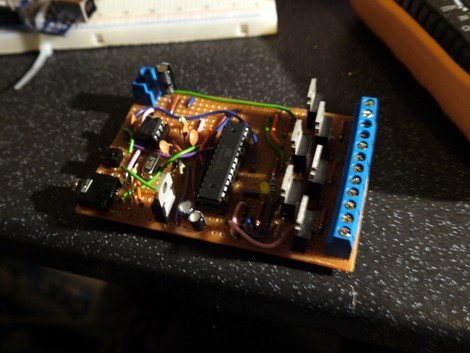
Careful planning and a steady hand let [Leo Rampen] fit everything he needed to build a graphic equalizer display on his LED wall sign. There’s a lot of components that needed to fit on this board, and he decided not use to an etched board for the build.
The idea for the project started off as just an LED sign. After spelling out “Sweat Box” using LED rope lights, he needed a way to switch them on and off. But why stop there? He also decided to use an MSGEQ7 chip in the build since the sign adorns their party-room and adding music-based flashing lights seemed like a good idea.
He laid out the equalizer chip, ATmega328 (running the Arduino bootloader) and a series of N-channel MOSFETS for switching the LEDS out in Eagle. With design in hand he grabbed a medium-sized piece of strip board and used a drill to cut the traces where necessary. In the end he has a very flashy sign as shown in the clip after the break.
















not to be too picky but this is a spectrum analyzer not an eq.
eq’s are used to shape the sound.
I initially labelled it an “equaliser” because that’s what the chip manufacturer and Sparkfun call it. You’re absolutely correct though. I suppose this is one of those words that ends up with a commonly accepted meaning which is wrong.
I’m not sure whether to change it in my writeup or not. I’d think (although obviously have no evidence to back this up) that the majority of people would equate “graphic equaliser” with bars that move up and down with the music – eg the “T-qualiser” tshirts that do a similar thing. Outside of the realms of scientific reporting, I don’t think definitions matter as much as conveying concepts does. In this context, most people will understand what’s meant.
Anyway, thanks for pointing that out! I hadn’t even considered your point, and it’s an interesting consideration to make.
I just had a seizure…
Nice!
I did something similar, just with pants xD
http://www.youtube.com/watch?v=uKxTuv7BwN8
need to finish the write up actually… :/
That’s awesome! Is it just LED strings wrapped round your legs?
Thanks man! no they are also using an MSGEQ7 to get the amplitude of the bass and mid frequency’s, doing some magic on an arduino and then controlling each color of each strip (48 channels, 12-bit PWM) using a few TI TLC5947 LED controllers..
little bit of info here: http://rambo.co.za/?p=275
will finish the story in the next week or so hopefully :D
I’ve always wanted a pin or e-textile thing that could do this. Just to show off some electro-savvy.
awesome. I can only thank. genius.
Please don’t use this term! Color organ has been in use for over a century. I have to explain to people over and over that bought stereos with some bouncing lights that may actually be a real graphic spectrum display, that they got ripped off when after much button pushing that we find THERE IS NO EQ! This is marketing that needs litigation in court, like HD radio. I am not sure what constitutes a spectrum display which is used to analyze said spectrum, but it needs more than on-off at two ranges of frequency. In the 60’s a cap and coil and triac was all it took and it was variable not on-off. It was graphic but art not engineering. Even worse are those phony spectrum displays on players soft or hard, just a few patterns rigged to volume level or random!
I said it in another comment, but my initial reasoning for the word “equalizer” is because that’s what the manufacturer of the chip used calls it.
But I agree, this isn’t really an equaliser, even by wrong (but commonly accepted) spectrum analyser standards. It’s a 2 frequency bandpass filter with thresholding for actuation. I did actually play around with linearly scaling intensity depending on the amplitude of the frequency, but it was more effective for the desired purposes with a simple on-off system. It might be interesting to try non-linear adjustment, but I don’t have time right now.
The IC is called “MSGEQ7 – Seven Band Graphic Equalizer Display Filter”. If you were building an EQ you could use this IC to provide analysis/feedback/visualization of the audio singal. It doesn’t do anything to the audio signal itself…
“The seven band graphic equalizer IC is a CMOS chip that divides the audio spectrum into seven bands. 63Hz, 160Hz, 400Hz, 1kHz, 2.5kHz, 6.25kHz and 16kHz. The seven frequencies are peak detected and multiplexed to the output to provide a DC representation of the amplitude of each band.”
im MY words:
a spectrum analyzer is an equalizer (lowpass/bandpass/highpass filters)
BUT with the outputs NOT connected together
this unit is cool, but way too on/off for me
at least in complete darkness…
i hate strobe lights!
needs analouge and maybe a AVC/AVL/ALC/AGC on each channel